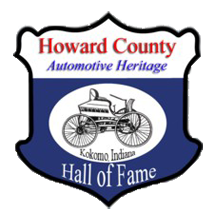

Automotive Heritage of Kokomo - Jonathan Maxwell part 1
John Dixon Maxwell was born on September 3, 1864 just east of Russiaville on what is now Indiana Highway 26. His father served in the War of 1812 and was 69 years old when he was born. John attended school until he was 14, then he began apprenticeship training at Star Machine Works in Kokomo. His first job was with the railroad in Brainerd, MN. He continued with the railroad after moving to Peru and to Huntington. In 1887, he married Nora Cockley of Peru. He then took a job with an elevator factory in Chicago, and then returned to his prior job at Peru, working for the Lake Erie and Western Railroad. He gained much mechanical experience and in 1893 he became the Superintendent of Star Machine Works. He was known to be extremely superior to most mechanics, according to Elmer Apperson.
As the first motorized carriage was being built for Elwood Haynes at the Riverside Machine Shop, the project had hit a snag. The project was moving too slow and Haynes asked Elmer if he could suggest an additional mechanic, who in turn said that Maxwell was the best possible person to move the project forward. Haynes called on Maxwell and hired him to work full time on the carriage. It was reported that he received .27 ½ cents an hour. At that time work days would be at least ten hours and a work week would have been six days. Overtime was not a part of anyone's vocabulary at that time.
Maxwell continued to work with Haynes and the Apperson brothers until 1899, when he was requested to build a gasoline engine for an experimental plow in Montreal. After that project he became an engineer for Ransom E. Olds. In 1901 he became manager of the machine shop at Michigan Yacht and Power Company. That position was only for a short period of time because Mr. Olds called on him and hired him to run the erection department in his automobile plant. In 1902, he was requested to start an automobile factory for the owners of the Detroit Stove Works. They wanted to get in the automobile business and Maxwell helped them establish the Northern Automobile Company. These constant job changes all were indications of business owners hiring the best person they could find to accomplish a task.
Maxwell desired to build a car that would carry the Maxwell name on it and he found Benjamin Briscoe, owner of a sheet metal business the provided metal to R. E. Olds. Briscoe was interested and had good connections with J. Pierpont Morgan, a New York banker. Morgan had a large building in Tarrytown, New York that had been used for a short period of time to build steam cars. The building was now empty. The Maxwell-Briscoe Motor Company was formed in 1903 and by October their first car was built. The cars would be called Maxwell and the company used the slogan, "Perfectly Simple, Simply Perfect." The automobile was an instant success and they produced 823 in 1905. Prices were from $750 to $1400 and they had to enlarge the original 149,000 square foot building several times over the early years. During the first eight years, the Maxwell ranked among the top ten best selling cars. In 1909 the company was ranked third.
Maxwell held 19 patents and some were major, such as thermal siphon cooling, which was used by other manufactures and paid good dividends to him. The company was also interested in racing and teamed up with Fritz Offenhauser. In 1905 the company built a 12 cylinder race car which was tested and recorded a speed of 115 mph.
In 1906, total automobile production for all of the American companies was 21,614, of which 11% were built in the Maxwell plant. It was time to expand. They choose New Castle, Indiana and on June 22, 1907 there was a ground breaking ceremony for the largest automobile factory in the country, more than 500,000 square feet. The event even attracted United States Vice President Charles W. Fairbanks.
Cadwallader Washburn Kelsey was the sales manager for Maxwell and he worked wonders in promoting the car. Some of his stunts, used in the silent movies, included teeterboard riding, chases with police cars and driving up steps of public buildings. In 1909, he hit a home run with the idea of having a woman drive from coast to coast. He encouraged 22 year old Alice Huyler Ramsey to be the driver. She had only driven a few months. She selected three additional female companions to ride along. None of her friends knew how to drive. Her car would be supported by a Maxwell team, which would follow her and a national news team. They started in New York City and traveled to the San Francisco Golden Gate Bridge. The entire trip took 53 days, 13 of which were in Iowa. The state had been hit with major rainstorms and the dirt roads were mud, mostly of the clay variety, which stuck to the wheels and could add up to 800 pounds to the car weight. Many stops had to be made to clean the mud off.